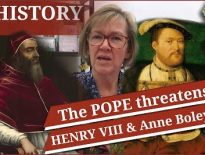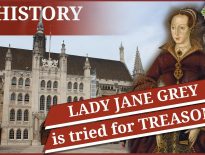On this day in Tudor history, 14th November and the Feast of St Erkenwald, there may have been two royal Tudor weddings. We know that Catherine of Aragon married Arthur, Prince of Wales, on 14th November 1501, but chronicler Edward Hall gives 14th November 1532 as the date of a secret wedding for King Henry VIII and Anne Boleyn, Marquess of Pembroke, in Dover.
Let me tell you all about the weddings of Catherine of Aragon and Arthur Tudor, and Henry VIII and Anne Boleyn. Scroll down for text rather than video.
Also on this day in history:
- 1531 – Birth of Richard Topcliffe, member of Parliament, priest-hunter, interrogator and torturer, in Lincolnshire. During the reign of Elizabeth I, Topcliffe was issued with warrants allowing him to use torture when examining imprisoned Catholic recusants and priests. His famous victims included Robert Southwell, John Gerard and Henry Garnet.
- 1539 – Hanging of Hugh Cook (Faringdon), Abbot of Reading, for treason, for upholding papal supremacy. He was born Hugh Cook, but took the name Faringdon when he took Benedictine orders.
- 1541 – An inventory was taken “of the goods and chattels, lands and fees of Thos. Culpeper, the younger”, the alleged lover of Queen Catherine Howard.
- 1559 – Death of Thomas Brydges, landowner, member of Parliament and administrator. He was buried at Chadlington in Oxfordshire. Brydges had been present at the execution of Lady Jane Grey while serving as Deputy Lieutenant of the Tower of London.
- 1581 – Death of Richard Bristow, Roman Catholic priest and scholar, while in prison for his faith. He died of consumption. Bristow is known for being one of the men responsible for the translation of the Douay-Rheims Bible.
This day in Tudor history, 14th November 1532, the Feast of St Erkenwald, might just have been Henry VIII and Anne Boleyn’s wedding day!
According to chronicler Edward Hall, who is usually a very reliable contemporary source, "The king, after his return married privily the lady Anne Boleyn on Saint Erkenwald’s day, which marriage was kept so secret, that very few knew it, til she was great with child, at Easter after."
The return that Hall is talking about here, is the couple’s return from Calais. Henry VIII and Anne Boleyn, Marquess of Pembroke, had gone to Calais over a month earlier to meet with King Francis I of France and to gain his support for their relationship. Their visit was successful and they had planned to set sail from Calais to Dover shortly after Francis I’s departure on 29th October, but bad weather delayed them. Edward Hall recorded:
"In November rose such a Wind, of the North and North West, that all the ships in Calais haven, were in great jeopardy, and in especial the Hoyes, at which season was such a spring tide, that it broke the walls of Holland and Zeeland, and drowned diverse towns in Flanders, in somuche that the water rose three foot above the wharf, where the Key stoode in Antwerp. This storm continued till the fourth day of November, but for all that the wind changed not. The eight day rose such a Wind tempest and Thunder, that no man could conveniently stir in the streets of Calais: muche lamentation was made for them that had taken ship into England, for no man knew what was become of them."
The storm had died down by Sunday 10th November, so the King’s bed and luggage were loaded on to the ship ready for departure but then a Channel fog came down and it was impossible to leave. Finally, at midnight on 12th November it was deemed safe to leave port. Henry and Anne arrived at Dover at 5am on Thursday 14th November, and there, they may well have got married.
The happy couple then spent a few days in the Dover area, allegedly to organise the building of harbours there, but perhaps it was a bit of a honeymoon, some time together before returning to the hustle and bustle of the royal court. They arrived at Eltham Palace in London on 24th November.
Did they marry or didn’t they? Well, we can’t know for sure, but whatever happened on St Erkenwald’s Day 1532, Henry and Anne began living together as man and wife from that point on and it wasn’t long before Anne became pregnant. On 25th January 1533, the Feast of St Paul, Henry VIII and Anne Boleyn got married in a[another] secret ceremony at Whitehall Palace.
Was Edward Hall correct in his dating of their marriage? I think so. It seems odd for them to suddenly risk pregnancy from that point on when they had waited so long.
But theirs wasn’t the only royal marriage to have taken place on St Erkenwald’s Day. On 14th November 1501, Catherine of Aragon, daughter of Isabella I of Castile and Ferdinand II of Aragon, married Arthur, Prince of Wales, son of King Henry VII, at St Paul’s Cathedral.
A huge wooden stage hung with say had been erected in the cathedral, the cathedral’s walls were covered with tapestries and there was a red carpeted raised circular dais.
Ten-year-old Prince Henry, the future Henry VIII, escorted his brother’s bride from the Bishop’s Palace to the cathedal door, while his maternal aunt, Lady Cecily of York, bore her train. Catherine’s white satin wedding dress was in the Spanish style, with a farthingale and “many pleats”, and her face was covered with a white silk veil decorated with a border of gold, pearls and gemstones. Her bridegroom, Prince Arthur, was also dressed in white satin.
The wedding began with the marriage agreements between England and Spain being read out, and Catherine’s dowry was announced. The bride was also given letters patent detailing her endowment and surety. Then, it was time for the religious part of the ceremony: the vows and mass. Catherine was then escorted out of the cathedral, to the sound of trumpets, by the young Henry while Arthur got himself ready to welcome her at the door of her chamber.
While the people of London enjoyed a pageant with a fountain running with wine, Catherine and Arthur enjoyed a sumptuous wedding banquet. The partying for this happy occasion went on two weeks, consisting of jousts, masques and banquets.
After the feasting, it was, of course, time for the wedding night, the consummation of their marriage. The question of whether this marriage was ever actually consummated is still debated today. When Henry VIII was trying to annul his marriage to Catherine in the late 1520 and early 1530s, Catherine vowed that she had never slept with Arthur and this is backed up by evidence heard in Zaragoza, Spain, in 1531. There, Juan de Gamarra, who had been a boy in Catherine’s service at the time of her wedding, told of how the Prince had got up early the morning after and that when he, Gamarra, had entered Catherine’s rooms her ladies were concerned for Catherine and disappointed with the Prince. Gamarra stated:
“Francisca de Cáceres, who was in charge of dressing and undressing the queen and whom she liked and confided in a lot, was looking sad and telling the other ladies that nothing had passed between Prince Arthur and his wife, which surprised everyone and made them laugh at him.”
However, English witnesses, tell of Arthur demanding ale the next morning, saying “for I have been this night in the midst of Spain!”
We will never know the truth of the matter.
Prince Arthur died in April 1502 and in 1509, Catherine married her brother-in-law, who had become King Henry VIII.



Hey, Claire, just out of curiosity… What do you think? I know there isn’t evidence either way, except Queen Catherine’s testimony. But what is your opinion? Did she and Arthur consulate their union? Michelle t
I keep changing my mind, but I’d find it very strange if they hadn’t consummated the marriage as they would have known that the marriage wasn’t legal and binding without consummation and they would also have known how important it was to get on and have children.